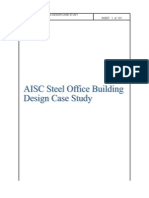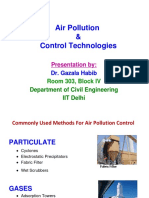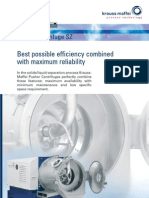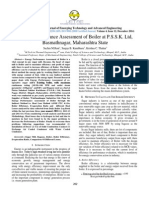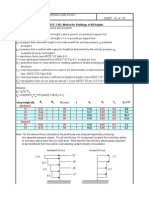Electrostatic Precipitator (ESP)
Uploaded by
avmurugan87Electrostatic Precipitator (ESP)
Uploaded by
avmurugan872012/10/6
1 Aerosol & Particulate Research Lab
Electrostatic Precipitator (ESP)
Electrical migration
Electrical mobility
Corona discharge
ESP theory
Charging mechanisms
Ash resistivity
Flue gas conditioning
Power consumption
Reading: Chap. 5
Positive
Negative
Republican
Democrat
Love Hate
Ying Yang
Man
Woman
Hell
Heaven
Cation
Anion
War
Peace
Attraction Repel
2012/10/6
2 Aerosol & Particulate Research Lab
Electrical Migration
Coulombs law
Statcoulomb (stC): the charge that causes a repulsive force of 1
dyne when 2 equal charges are separated by 1 cm (3.3310
-10
C)
Unit charge: 4.8 10
-10
stC (1.610
-19
C)
2
2 1
r
q q
K F
E E
=
E
F
q
E
=
(q=ne)
Electric Field
2012/10/6
3 Aerosol & Particulate Research Lab
Millikan Experiment
(Robert Millikan,
US, 1868-1953;
Nobel Prize
Laureate, 1923)
Hinds, Aerosol Technology, 1999
http://nobelprize.org/nobel_prizes/physics/laureates/1923/millikan-bio.html
2012/10/6
4 Aerosol & Particulate Research Lab
Electrical Mobility
Terminal velocity in an electrical field
(electrical migration velocity/drift velocity)
c
TE p
C
V d
qE
t 3
=
( ) qEB
d
qEC
w V
p
c
TE
= = =
t 3
qB
d
qC
E
V
Z
p
c TE
= = =
t 3
(force balance)
D E
F F =
(for Re < 1)
Q: What is the physical meaning of electrical mobility?
Q: When does a particle have a higher mobility?
May the force be with the particles!
Q: Difference between cyclone
and ESP in terms of forces
acting on the system? Whats
the effect?
2012/10/6
5 Aerosol & Particulate Research Lab
Positive Corona Negative Corona
+
-
+
-
+
+
-
+
+
+
-
-
+
-
+
-
+
-
-
-
+
+
Corona Discharge
Step 1
Step 2
Step 3
Step 4
Collection Plate
Collection Plate
Electron
Molecule
Particle
Electrode
Electrode
Q: How can we generate charges?
Ozone generation - http://www.mtcnet.net/~jdhogg/ozone/ozonation.html
2012/10/6
6 Aerosol & Particulate Research Lab
1
2 3
1 2
3
(20)
(12)
(8)
Turbulent Flow with Lateral Mixing Model
Electrostatic Precipitator
2012/10/6
7 Aerosol & Particulate Research Lab
Deutsch-Anderson Equation
R
dt V
R
dt RV
N
dN
TE TE
2 2
2
= =
t
t
)
2
exp(
) (
0
R
t V
N
t N
TE
=
|
|
.
|
\
|
= = q
Q
A V
P
c TE
exp 1 1
A
c
/Q: Specific Collection Area (SCA)
Turbulent flow: uniformly mixing
Perfect Collection
The fraction of the particles
removed in unit time = the ratio of
the area traveled by drift velocity
in unit time to the total cross-
section
Q: How to increase the efficiency?
2012/10/6
8 Aerosol & Particulate Research Lab
Q: An ESP that treats 10,000 m
3
/min of air is
expected to be 98% efficient. The effective
drift velocity of the particles is 6.0 m/min. (a)
What is the total collection area? (b) Assuming
the plates are 6 m high and 3 m long, what is
the number of plates required?
6 m
3 m
Internal Configuration: self-review
2012/10/6
9 Aerosol & Particulate Research Lab
Charging Mechanism: Diffusion Charging
Random collisions between
ions and particles
(
(
+ =
kT
t N e c d
e
kT d
n
i i p p
2
1 ln
2
2
2
t
Q: Does q depend on time?
Does q depend on d
p
?
The total number of charges on a particle
(c
i
~ 2.410
4
cm/s)
ne q =
The total charges on a particle
Use esu, not SI units.
2012/10/6
10 Aerosol & Particulate Research Lab
Charging Mechanism: Field Charging
Bombardment of ions in the presence of a strong field
eZ 1
eZ
4 2
3
i
i
2
|
|
.
|
\
|
+
|
|
.
|
\
|
|
.
|
\
|
+
=
t N
t N
e
Ed
n
i
i
p
t
t
c
c
Total number of charges by field charging
Q: Is the charging rate dependent on
particle size? On field strength? On time?
On material?
Aerosol Technology, Hinds, W. C., John Wiley & Sons, 1999.
|
|
.
|
\
|
|
.
|
\
|
+
=
e
Ed
n
p
s
4 2
3
2
c
c
Saturation charge
(Z
i
~ 450 cm
2
/stVs)
2012/10/6
11 Aerosol & Particulate Research Lab
Comparison of Diffusion & Field Charging
Q: Does collection efficiency
increase as particle size increase
(because of a higher number of
charges)?
dp (um) n
diff
n
field
n
total
Z
diff
Z
Field
Z (stCs/g)
0.01 0.10 0.02 0.12 0.66 0.10 0.76
0.02 0.30 0.06 0.36 0.49 0.11 0.60
0.05 1.1 0.40 1.50 0.31 0.12 0.43
0.1 2.8 1.6 4.38 0.23 0.13 0.36
0.2 7 6.5 13.2 0.18 0.17 0.35
0.5 21 40 61.2 0.15 0.30 0.45
1 48 161 209 0.16 0.52 0.68
2 108 646 754 0.16 0.98 1.14
5 311 4035 4346 0.18 2.34 2.52
10 683 16140 16824 0.20 4.61 4.80
20 1490 64562 66052 0.21 9.16 9.37
50 4134 403510 407644 0.23 22.78 23.0
Number of Charges vs dp
dp (um)
0.01 0.1 1 10
n
10
-2
10
-1
10
0
10
1
10
2
10
3
10
4
10
5
10
6
Diffusion charging
Field Charging
Nit = 10
7
s/cm
3
c= 5.1
E = 5 KV/cm
T = 298 K
2012/10/6
12 Aerosol & Particulate Research Lab
ELectrical Mobility vs dp
dp (um)
0.01 0.1 1 10
Z
(
s
t
C
.
s
/
g
)
0.1
1
10
Diffusion charging
Field Charging
Combined Charging
Typical fly ash
size distribution
Q: If the ESP is used to collect the
fly ash, how will the particle size
distribution at ESP outlet look like?
2012/10/6
13 Aerosol & Particulate Research Lab
Resistivity/Conductivity
Impact of particles resistivity on ESPs performance:
Factors: temperature, composition
Flue gas conditioning
10
9
- 10
10
ohm-cm is desired
Q: How does resistivity affect an ESPs performance?
2012/10/6
14 Aerosol & Particulate Research Lab
Effects of sulfur content and temperature on resistivity
Q: Is S in coal good or bad?
2012/10/6
15 Aerosol & Particulate Research Lab
Water spray for cement kiln dust
Flue Gas Conditioning
2012/10/6
16 Aerosol & Particulate Research Lab
Effective drift velocity as a function of resistivity by measurement
Use the same Deutsch-Anderson Equation with new w
e
.
Q: Estimate the total collection area required for a 95% efficient fly-ash ESP
that treats 8000 m
3
/min. The ash resistivity is 1.610
10
ohm-cm.
2012/10/6
17 Aerosol & Particulate Research Lab
Good for moderate
collection efficiency
(90% ~ 95%)
2012/10/6
18 Aerosol & Particulate Research Lab
High Efficiency ESP (>95%)
Matts-Ohnfeldt Equation
(
(
|
|
.
|
\
|
=
k
e
C
w
Q
A
exp 1 q
Use k = 1 for fly ash
k = 0.5 or 0.6 for
industrial category
Rule of Thumb
Below 95%, use Deutsch-Anderson Equation
Above 99%, use Matts-Ohnfeldt Equation
Between them, use an average
Q: In designing a high
efficiency ESP, a smaller
drift velocity is to be used.
Why?
2012/10/6
19 Aerosol & Particulate Research Lab
Power Consumption
avg C C
V I P =
C
C
e
A
kP
w =
Power density ~ 1-2 W/ft
2
|
|
.
|
\
|
=
Q
kP
C
exp 1 q
Corona power
Drift velocity
Efficiency vs. Corona Power
k = 0.55 for P
c
/Q in W/cfs up to 98.5%
2012/10/6
20 Aerosol & Particulate Research Lab
Quick Reflection
You might also like
- Project: Steel Building Design Case Study Subject: Project Plan SHEET 1 of 131No ratings yetProject: Steel Building Design Case Study Subject: Project Plan SHEET 1 of 13122 pages
- Sizing Calculation of Dry Electro-Static Precipitator (DESP)No ratings yetSizing Calculation of Dry Electro-Static Precipitator (DESP)12 pages
- Round and Rectangular Duct Structural DesignNo ratings yetRound and Rectangular Duct Structural Design1 page
- DEMZ-Engineering LTD: Electrostatic PrecipitatorsNo ratings yetDEMZ-Engineering LTD: Electrostatic Precipitators10 pages
- T.E. Mechanical (A-4) MONIL DOSHI-0815054 KIRAN PATIL - 1125027 JIGAR SHAH - 0815045No ratings yetT.E. Mechanical (A-4) MONIL DOSHI-0815054 KIRAN PATIL - 1125027 JIGAR SHAH - 081504519 pages
- Sample Computation For A Steam Pipe LineNo ratings yetSample Computation For A Steam Pipe Line3 pages
- Design Theory of Circulating Fluidized Bed Boilers: KeywordsNo ratings yetDesign Theory of Circulating Fluidized Bed Boilers: Keywords15 pages
- Electrostatic Precipitator and Ash Handling SystemNo ratings yetElectrostatic Precipitator and Ash Handling System20 pages
- Effective Dust Collection - Capturing Dust and Accounting For LoadingNo ratings yetEffective Dust Collection - Capturing Dust and Accounting For Loading4 pages
- Strength Calculation As Per Ibr Boiler Maker'S No.: Atpl-Rb002No ratings yetStrength Calculation As Per Ibr Boiler Maker'S No.: Atpl-Rb0029 pages
- Piping Material Specification - Tsmto 99fu M 99 Pt0 001 Rev0!3!65100% (1)Piping Material Specification - Tsmto 99fu M 99 Pt0 001 Rev0!3!6564 pages
- Pneumatic Powder Transport: by Erik Karlsen, M.SC., Ehk@tekfa - DK, TEKFA A/SNo ratings yetPneumatic Powder Transport: by Erik Karlsen, M.SC., Ehk@tekfa - DK, TEKFA A/S4 pages
- Design and Analysis of Screw Conveyor at Inlet of Ash/Dust ConditionerNo ratings yetDesign and Analysis of Screw Conveyor at Inlet of Ash/Dust Conditioner6 pages
- Transport of Particulate Solids in The Presence of A Gas. Pneumatic Transport (Pneumatic Conveying)No ratings yetTransport of Particulate Solids in The Presence of A Gas. Pneumatic Transport (Pneumatic Conveying)8 pages
- T7111-DAS-1053-A-IFA-Baghouse Datasheet - 20170930 PDFNo ratings yetT7111-DAS-1053-A-IFA-Baghouse Datasheet - 20170930 PDF4 pages
- Evaporation Principles and Black Liquor Properties: David T. Clay, PH.DNo ratings yetEvaporation Principles and Black Liquor Properties: David T. Clay, PH.D6 pages
- Improve The Efficiency of Boiler by Reduce The Moisture in Bagasse IJERTCONV6IS07115100% (1)Improve The Efficiency of Boiler by Reduce The Moisture in Bagasse IJERTCONV6IS071158 pages
- IS 8531 (1986) - Pulleys For Belt ConveyorsNo ratings yetIS 8531 (1986) - Pulleys For Belt Conveyors6 pages
- Static Structural Analysis of Crushing Rollers of Three Roller Sugar Mill IJERTV4IS051293No ratings yetStatic Structural Analysis of Crushing Rollers of Three Roller Sugar Mill IJERTV4IS0512937 pages
- Energy Performance Assessment of Boiler at P.S.S.K. LTDNo ratings yetEnergy Performance Assessment of Boiler at P.S.S.K. LTD12 pages
- Sugar Research & Innovation, Queensland University of Technology, AustraliaNo ratings yetSugar Research & Innovation, Queensland University of Technology, Australia10 pages
- Material Handling Systehls For THE Fluidized-Bed Combustion Boiler Rivesville, J. Rranam Rosborough The MITRE CcrporationNo ratings yetMaterial Handling Systehls For THE Fluidized-Bed Combustion Boiler Rivesville, J. Rranam Rosborough The MITRE Ccrporation20 pages
- ESP For Bagasse Fired Steam Generators Seminar100% (2)ESP For Bagasse Fired Steam Generators Seminar14 pages
- 3223some Issues of Optimizing The Schemes of Pneumatic Ash Removal Systems of Thermal Power PlantsNo ratings yet3223some Issues of Optimizing The Schemes of Pneumatic Ash Removal Systems of Thermal Power Plants6 pages
- Sl. No. Duct Root Velocity M/S, V Duct Dia (MM)No ratings yetSl. No. Duct Root Velocity M/S, V Duct Dia (MM)20 pages
- Application of The New Mixing and Granulation Technology of Raw Materials For Iron Ore Sintering ProcessNo ratings yetApplication of The New Mixing and Granulation Technology of Raw Materials For Iron Ore Sintering Process4 pages
- Wind Load Analysis in Trees in Accordance With Eurocode 1, Part 2-4. Peter SterkenNo ratings yetWind Load Analysis in Trees in Accordance With Eurocode 1, Part 2-4. Peter Sterken1 page
- WIND LOAD ANALYSIS (Per ASCE 7-02), Method For Buildings of All HeightsNo ratings yetWIND LOAD ANALYSIS (Per ASCE 7-02), Method For Buildings of All Heights2 pages
- Section - Properties - Steel - ProfilesNo ratings yetSection - Properties - Steel - Profiles25 pages
- Project: Steel Building Design Case Study Subject: Project Plan SHEET 1 of 131Project: Steel Building Design Case Study Subject: Project Plan SHEET 1 of 131
- Sizing Calculation of Dry Electro-Static Precipitator (DESP)Sizing Calculation of Dry Electro-Static Precipitator (DESP)
- T.E. Mechanical (A-4) MONIL DOSHI-0815054 KIRAN PATIL - 1125027 JIGAR SHAH - 0815045T.E. Mechanical (A-4) MONIL DOSHI-0815054 KIRAN PATIL - 1125027 JIGAR SHAH - 0815045
- Design Theory of Circulating Fluidized Bed Boilers: KeywordsDesign Theory of Circulating Fluidized Bed Boilers: Keywords
- Electrostatic Precipitator and Ash Handling SystemElectrostatic Precipitator and Ash Handling System
- Effective Dust Collection - Capturing Dust and Accounting For LoadingEffective Dust Collection - Capturing Dust and Accounting For Loading
- Strength Calculation As Per Ibr Boiler Maker'S No.: Atpl-Rb002Strength Calculation As Per Ibr Boiler Maker'S No.: Atpl-Rb002
- Piping Material Specification - Tsmto 99fu M 99 Pt0 001 Rev0!3!65Piping Material Specification - Tsmto 99fu M 99 Pt0 001 Rev0!3!65
- Pneumatic Powder Transport: by Erik Karlsen, M.SC., Ehk@tekfa - DK, TEKFA A/SPneumatic Powder Transport: by Erik Karlsen, M.SC., Ehk@tekfa - DK, TEKFA A/S
- Design and Analysis of Screw Conveyor at Inlet of Ash/Dust ConditionerDesign and Analysis of Screw Conveyor at Inlet of Ash/Dust Conditioner
- Transport of Particulate Solids in The Presence of A Gas. Pneumatic Transport (Pneumatic Conveying)Transport of Particulate Solids in The Presence of A Gas. Pneumatic Transport (Pneumatic Conveying)
- T7111-DAS-1053-A-IFA-Baghouse Datasheet - 20170930 PDFT7111-DAS-1053-A-IFA-Baghouse Datasheet - 20170930 PDF
- Evaporation Principles and Black Liquor Properties: David T. Clay, PH.DEvaporation Principles and Black Liquor Properties: David T. Clay, PH.D
- Improve The Efficiency of Boiler by Reduce The Moisture in Bagasse IJERTCONV6IS07115Improve The Efficiency of Boiler by Reduce The Moisture in Bagasse IJERTCONV6IS07115
- Static Structural Analysis of Crushing Rollers of Three Roller Sugar Mill IJERTV4IS051293Static Structural Analysis of Crushing Rollers of Three Roller Sugar Mill IJERTV4IS051293
- Energy Performance Assessment of Boiler at P.S.S.K. LTDEnergy Performance Assessment of Boiler at P.S.S.K. LTD
- Sugar Research & Innovation, Queensland University of Technology, AustraliaSugar Research & Innovation, Queensland University of Technology, Australia
- Material Handling Systehls For THE Fluidized-Bed Combustion Boiler Rivesville, J. Rranam Rosborough The MITRE CcrporationMaterial Handling Systehls For THE Fluidized-Bed Combustion Boiler Rivesville, J. Rranam Rosborough The MITRE Ccrporation
- 3223some Issues of Optimizing The Schemes of Pneumatic Ash Removal Systems of Thermal Power Plants3223some Issues of Optimizing The Schemes of Pneumatic Ash Removal Systems of Thermal Power Plants
- Application of The New Mixing and Granulation Technology of Raw Materials For Iron Ore Sintering ProcessApplication of The New Mixing and Granulation Technology of Raw Materials For Iron Ore Sintering Process
- Wind Load Analysis in Trees in Accordance With Eurocode 1, Part 2-4. Peter SterkenWind Load Analysis in Trees in Accordance With Eurocode 1, Part 2-4. Peter Sterken
- WIND LOAD ANALYSIS (Per ASCE 7-02), Method For Buildings of All HeightsWIND LOAD ANALYSIS (Per ASCE 7-02), Method For Buildings of All Heights
